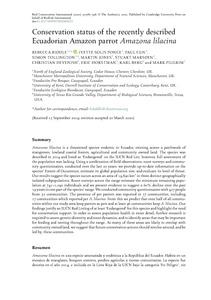Biddle, R, Solis Ponce, I, Cun, P, Tollington, S, Jones, M 


![[img]](https://e-space.mmu.ac.uk/628886/1.hassmallThumbnailVersion/conservation-status-of-the-recently-described-ecuadorian-amazon-parrot-amazona-lilacina.pdf)
|
Accepted Version
Available under License In Copyright. Download (559kB) | Preview |
Abstract
Amazona lilacina is a threatened species endemic to Ecuador, existing across a patchwork of mangroves, lowland coastal forests, agricultural and community owned land. The species was described in 2014 and listed as 'Endangered' on the IUCN Red List, however, full assessment of the population was lacking. Using a combination of field observations, roost surveys and community questionnaires, conducted over the last 20 years, we provide up-to-date information on the species' Extent of Occurrence, estimate its global population size, and evaluate its level of threat. Our results suggest the species occurs across an area of 19,890 km2 in three distinct geographically isolated subpopulations. Roost surveys across the range estimate the minimum remaining population at 741-1,090 individuals and we present evidence to suggest a 60% decline over the past 19 years in one part of the species' range. We conducted community questionnaires with 427 people from 52 communities. The presence of pet parrots was reported in 37 communities, including 17 communities which reported pet A. lilacina. From this we predict that over half of all communities within our study area keep parrots as pets and at least 96 communities keep A. lilacina. Our findings justify an IUCN Red Listing of at least 'Endangered' for this species and highlight the need for conservation support. In order to assess population health in more detail, further research is required to assess genetic diversity and roost dynamics, and to identify areas that may be important for feeding and nesting throughout the range. As many of these areas are likely to overlap with community owned land, we suggest that future conservation actions should revolve around, and be led by, these communities.
Impact and Reach
Statistics
Additional statistics for this dataset are available via IRStats2.



